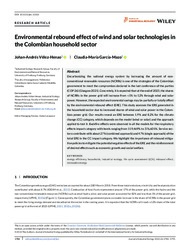Environmental rebound effect of wind and solar technologies in the Colombian household sector
DOI: https://doi.org/10.1111/jiec.13326
Persistent URL: http://resolver.sub.uni-goettingen.de/purl?gldocs-11858/10464
Persistent URL: http://resolver.sub.uni-goettingen.de/purl?gldocs-11858/10464
Vélez‐Henao, Johan‐Andrés; García‐Mazo, Claudia‐María, 2022: Environmental rebound effect of wind and solar technologies in the Colombian household sector. In: Journal of Industrial Ecology, Band 26, 5: 1784 - 1795, DOI: 10.1111/jiec.13326.
 |
Dokument öffnen: |
Decarbonizing the national energy system by increasing the amount of non‐conventional renewable resources (NCRRs) is one of the strategies of the Colombian government to meet the compromises declared in the last conference of the parties (COP 26) (Glasgow 2021). Concretely, it is expected that at the end of 2023, the shares of NCRRs in the power grid will increase from <1% to 12% through wind and solar power. However, the expected environmental savings may be partially or totally offset by the environmental rebound effect (ERE). This study assesses the ERE generated in the household sector due to increased shares of wind and solar power in the Colombian power grid. Our results reveal an ERE between 1.9% and 8.2% for the climate change (CC) category, which depends on the model (wind or solar) and the approach applied to test it. Backfire effects were observed in all the models for the respiratory effects impact category with levels ranging from 119,469% to 376,605%. Service sectors contribute with about 27% (combined approach) and 47% (single approach) of the total ERE in the CC impact category. We highlight the importance of rebound mitigation policies to mitigate the potential negative effects of the ERE and the reinforcement of desired effects such as economic growth and social welfare.
Statistik:
ZugriffsstatistikSammlung:
Schlagworte:
energy efficiencyhouseholds
industrial ecology
life cycle assessment (LCA)
rebound effect
renewable energy
This is an open access article under the terms of the Creative Commons Attribution‐NonCommercial‐NoDerivs License, which permits use and distribution in any medium, provided the original work is properly cited, the use is non‐commercial and no modifications or adaptations are made.

